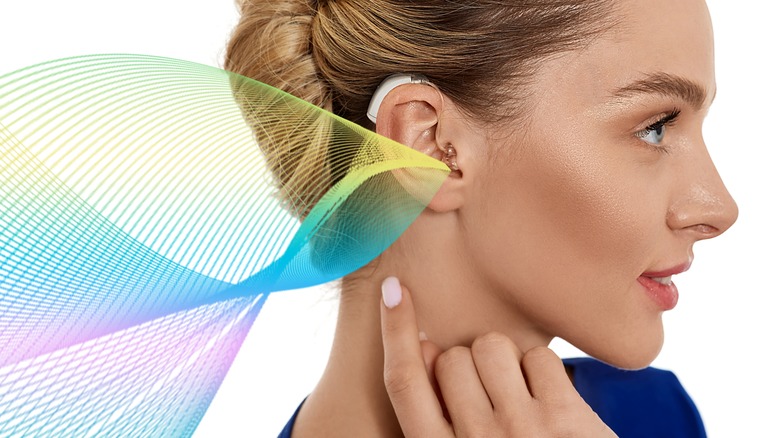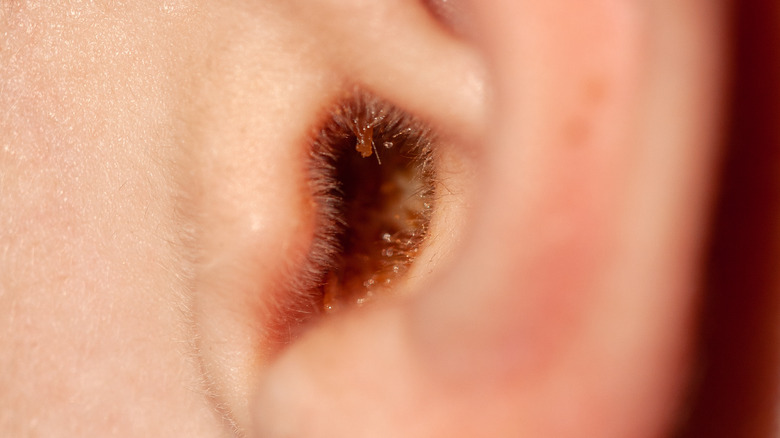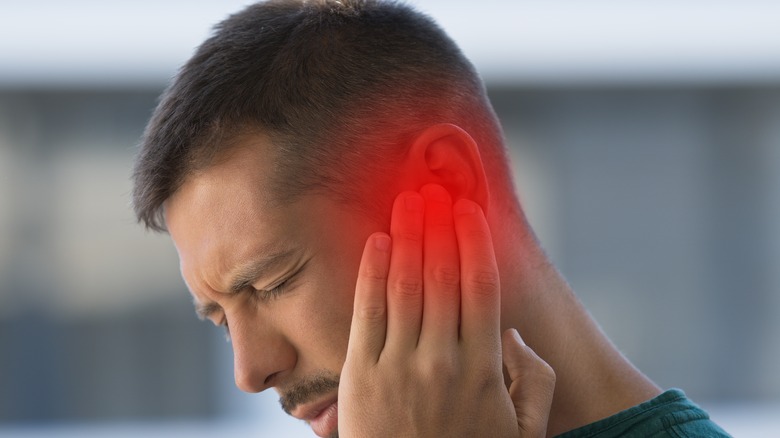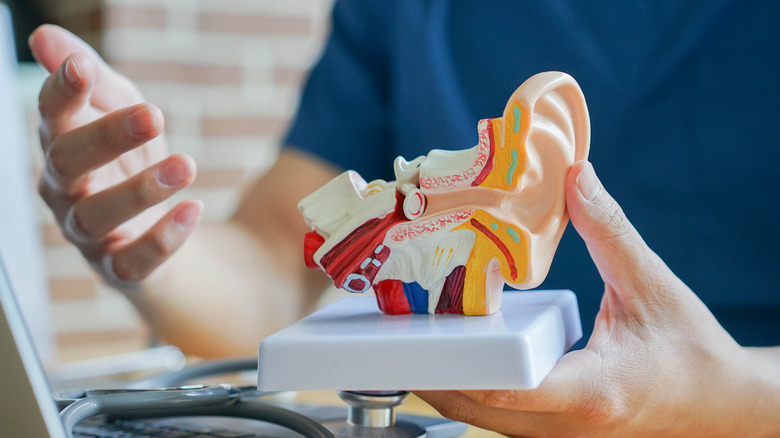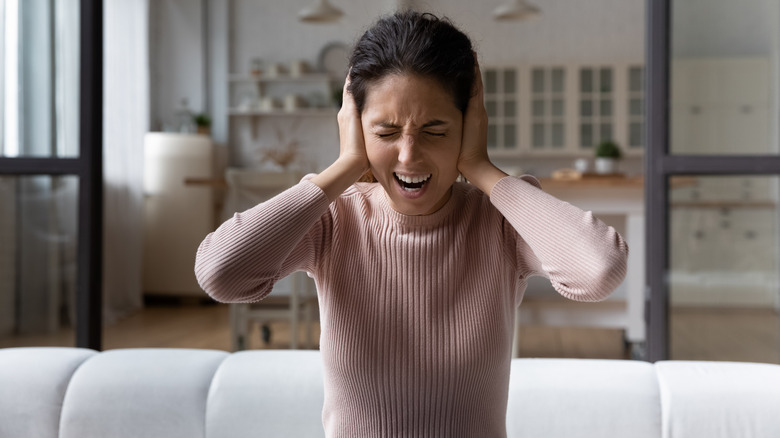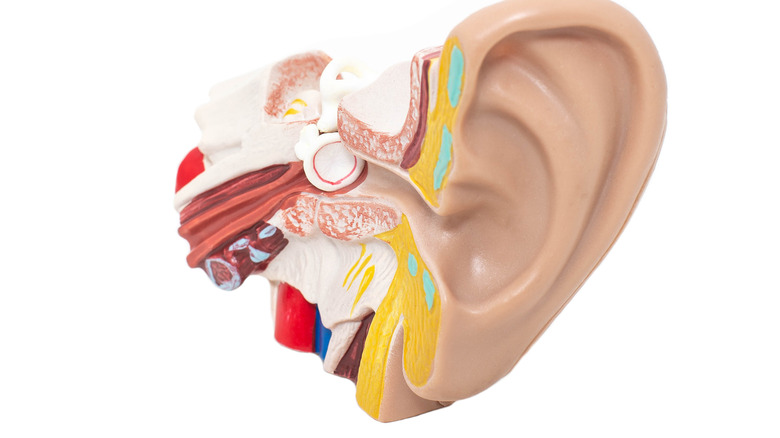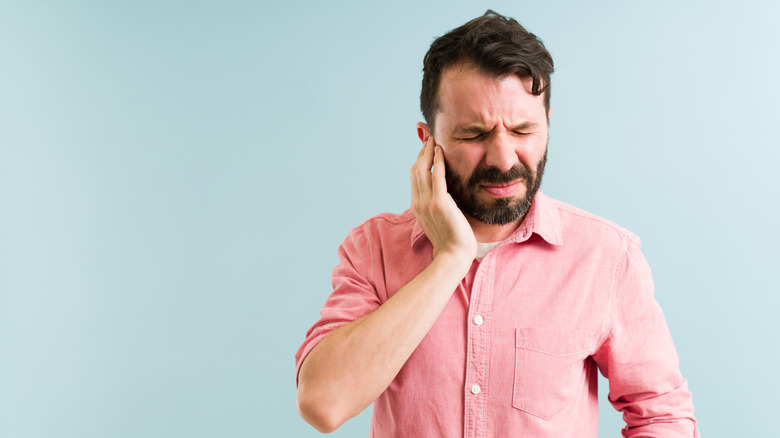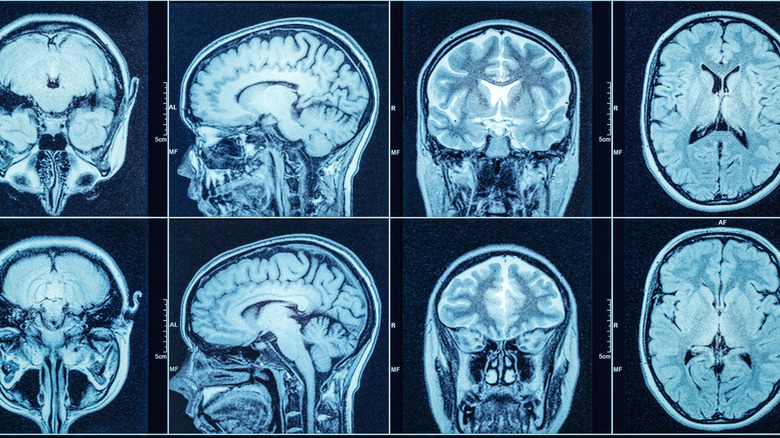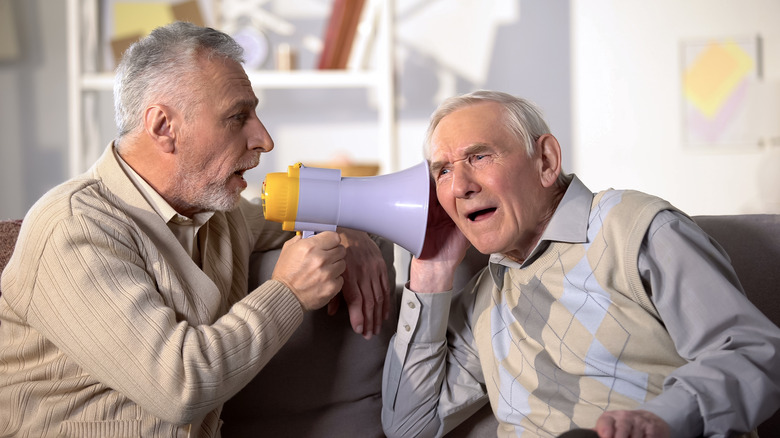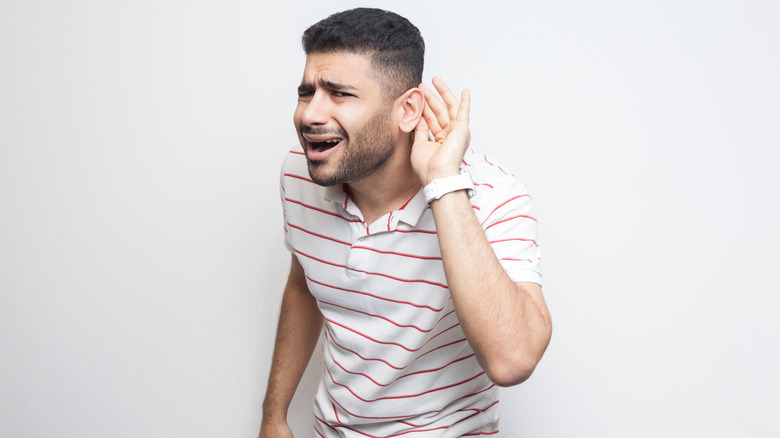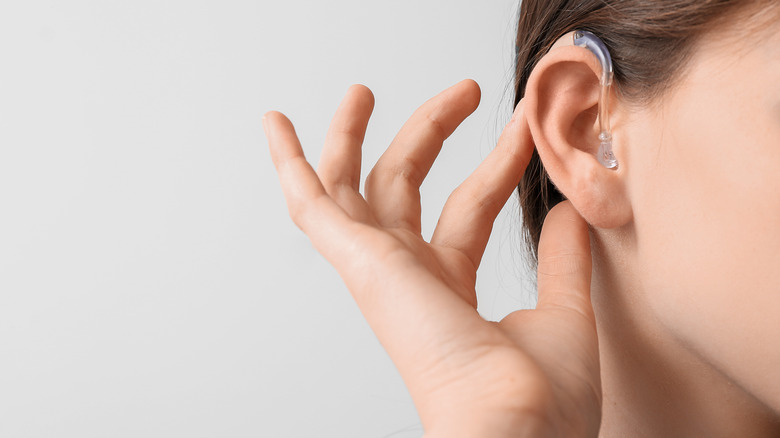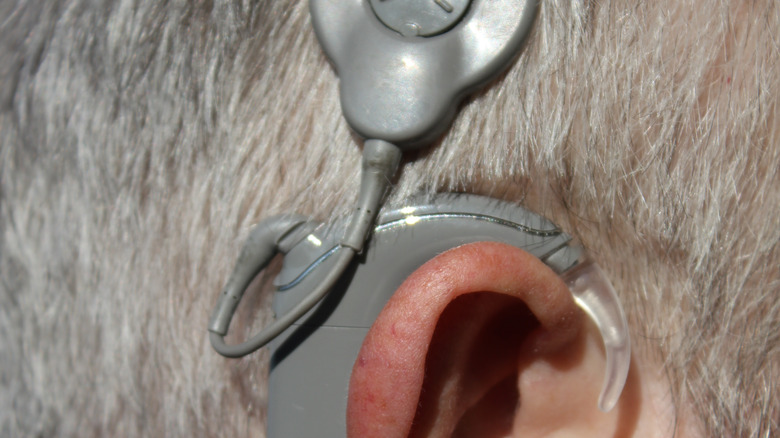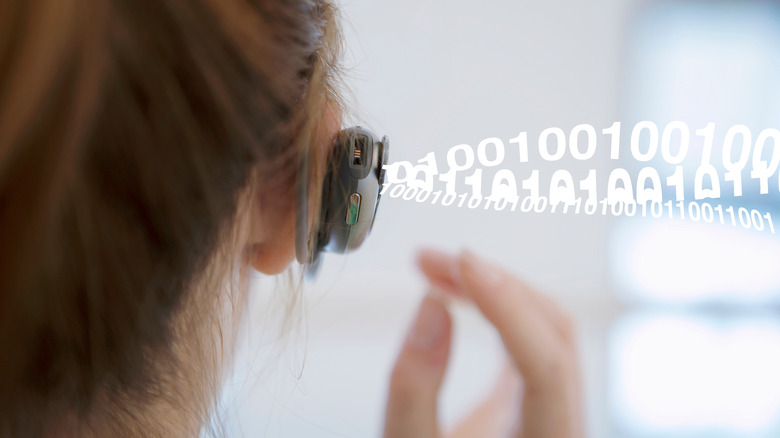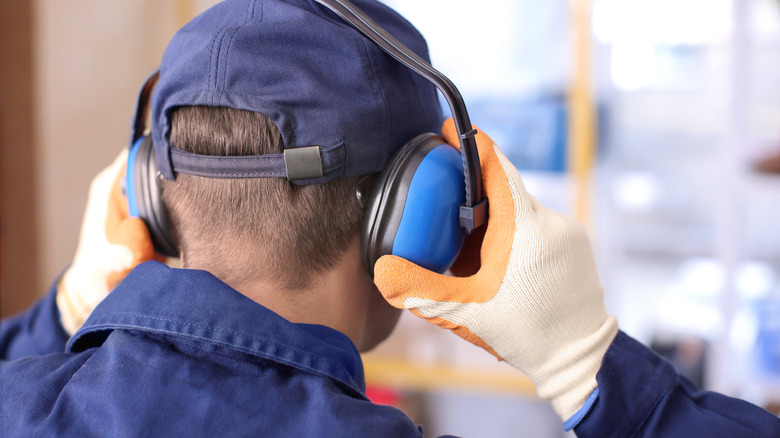Hearing Loss Explained: Causes, Symptoms, And Treatments
According to the Centers for Disease Control and Prevention (CDC) hearing loss occurs when part of your auditory system, including your ear, fails to work correctly. There are several different classifications of hearing loss. Mild hearing loss allows you to hear all but soft sounds. You have moderate hearing loss if you can't hear someone speaking in a regular tone. Hearing loss is considered severe if you can only hear loud noises — and profound hearing loss occurs when you cannot hear anything but exceptionally loud noises.
Professionals at the Mayo Clinic classify hearing loss based on the parts of the ear affected. Conductive hearing loss develops from the outer or middle ear. Hearing loss is considered sensorineural if the inner ear is the cause. Mixed hearing loss is a combination of both conductive and sensorineural.
Other ways that hearing loss is described include whether it occurs in one or both ears (unilateral or bilateral) and if your hearing loss occurred before or after you learned to speak (pre or post-lingual). Doctors also characterize hearing based on whether it's the same in both ears (symmetrical or asymmetrical), if it happened suddenly or progresses over time, if it fluctuates with time or remains stable, and if your hearing loss was present at birth (per CDC).
Regardless of how it's labeled, the World Health Organization (WHO) reports that more than 430 million people worldwide currently require some help due to their hearing loss, and that number will nearly double to 700 million by 2050.
Earwax buildup resulting in hearing loss
Your ears emit secretions that blend with dead skin cells to create the waxy, yellowish substance known as earwax. Earwax protects your ears from water, infections, and injuries caused by objects placed in your ear (per Cedars-Sinai). Earwax typically gets pushed through your ear as skin cells grow and your jaw moves.
However, some people make too much earwax (via Scientific American). Others have an abundance of hair in their ear canals, slowing the process down. Additionally, placing foreign objects, including hearing aids and cotton swabs, disrupts wax flow, according to the National Institute for Health and Care Excellence (NICE). Furthermore, according to an American Academy of Otolaryngology-Head and Neck Surgery Foundation report to Scientific American, earwax buildup causes over 10 million people to seek medical attention annually.
Moreover, nearly 10% of participants (experienced hearing loss) in a study published in the Nigerian Quarterly Journal of Hospital Medicine due to earwax impaction. The report by NICE states that, though usually temporary, losing your hearing due to impacted earwax can start as annoying and end up causing social isolation if left untreated.
While over-the-counter remedies are available to soften and aid in earwax removal, Healthline recommends using caution with these products and never digging it out on your own. If the problem persists, make an appointment with your doctor.
Ear infections causing hearing loss
The germs from a cold, sore throat or upper respiratory infection can travel to your middle ear, resulting in an ear infection. The bacteria cause inflammation, and the resulting swelling causes fluid to build up behind your ear drum. In fact, by age 3, five out of six children have had an ear infection, according to the National Institute on Deafness and Other Communication Disorders (NIDCID).
The professionals at Boston Medical Center (BMC) report that the hearing loss related to fluid buildup is similar to wearing ear plugs, but can interfere with understanding regular speaking. According to Healthline, hearing loss quickly dissipates when the swelling goes down, and the fluid is no longer trapped, hindering sound vibration transmission.
Doctors associated with NIDCID explain that there are three common types of ear infections. Acute otitis media (AOM) affects the middle ear and causes pain, often accompanied by a fever. Otitis media with effusion (OME) results from trapped fluid from a previous infection. Additionally, doctors diagnose chronic otitis media with effusion (COME) when liquid remains in the ear for an extended period or returns frequently.
Over-the-counter pain medications and antibiotics are the most common treatment. In addition, doctors may insert tubes in those with persistent middle ear fluid that lasts more than three months and is accompanied by hearing loss (via Healthy Hearing).
Ruptured eardrums and hearing loss
Your eardrum or tympanic membrane is a thin cone-shaped tissue separating your middle and outer ear. Your eardrum is also charged with turning sound waves into nerve impulses by vibrating when the transmission reaches it (per Desert Hearing Care). The nerve signals then go to your brain enabling you to hear. Additionally, your eardrum also protects the inside of your ear by keeping water and dirt out (via Merck Manual).
Doctors at Desert Hearing Care explain that the eardrum is often damaged by fluid buildup related to an infection, a change in pressure, loud noises, and head trauma. Additionally, JAMA Otolaryngology released a report that showed that nearly two-thirds of the almost 1,000 emergency room visits related to ruptured eardrums were caused by inserting foreign objects into the ear. Furthermore, of those, roughly half involved a cotton-tipped applicator or Q-tip.
Medical professionals at Icahn School of Medicine at Mount Sinai report that hearing loss associated with a perforated eardrum generally lasts until the injury heals, which could be up to two months. While the eardrum often heals itself, the NHS recommends seeing your doctor if pain persists for longer than a few days.
Excessive noise exposure relating to hearing loss
The Centers for Disease Control and Prevention (CDC) reports that nearly 40 million American adults have hearing loss due to noise, and only 25% think they have a problem. Additionally, by 2030, the first year of treatment is expected to cost upwards of $51 billion.
Located in your inner ear are approximately 16,000 hairs that can be harmed or killed by loud noises, and you won't know there's a problem until at least 30% are impaired or dead. While you might temporarily have trouble with sound after a concert or other loud event, permanent hearing loss often occurs after prolonged exposure to blaring sounds and makes it so that you slowly lose the ability to understand speech (per CDC).
The CDC also states that excessive noise can damage your ears' nerves, making hearing conversations difficult. A study out of Keck Medicine of USC links this nerve damage to fluid buildup in the inner ear.
Noise is measured in decibels (dB). For example, the average washing machine runs at 70 dB, a leaf blower emits 90 dB, and a siren wails at 120 dB. The louder a sound and the longer you hear it, the more damage is done (via the CDC). If you feel you've been exposed to excessively loud noise, the CDC also recommends seeing a medical professional to discuss your hearing concerns after exposure.
Otosclerosis
Bone remodeling occurs over your entire life. Unfortunately, this regeneration process goes askew in the inner ear for the more than 3 million Americans with otosclerosis. Otosclerosis causes the hardest bone in your body to grow and solidify around the bones responsible for moving sound waves from your eardrum to your inner ear, limiting vibrations and hindering the hearing process (per American Hearing Research Foundation).
The NHS reports that hearing loss from otosclerosis is most prevalent in people in their 20s and 30s. Unlike other causes of hearing loss, otosclerosis makes it hard to hear low and deep sounds and whispers, even though this type of hearing loss causes you to whisper because your voice seems loud. Additionally, those with otosclerosis hear better with background noise.
Medical professionals at the Mayo Clinic treat mild hearing loss associated with otosclerosis using hearing aids. For more severe cases, doctors perform a stapedectomy. The surgery involves placing an artificial bone in your middle ear to enable sound waves to travel to your inner ear.
According to the American Hearing Research Foundation, the exact cause of otosclerosis is unknown. However, genetics make you more prone to develop the disorder if a family member has this diagnosis. Additionally, pregnancy seems to accelerate the onset of symptoms.
Meniere's disease
Your inner ear has two sections, the bony and membranous labyrinths. The membranous labyrinth is filled with fluid and houses the cochlea. In response to sound waves, the liquid gets constricted to enable brain stimulation. Those with Meniere's disease have a fluid buildup that obstructs both balance and hearing, according to the National Institute on Deafness and Other Communication Disorders (NIDCID)
According to the Hearing Health Foundation, Meniere's disease affects approximately 750,000 Americans, with around 50,000 new diagnoses each year. Most people with Meniere's disease are over 40 and start with symptoms in one ear. Medical professionals at the Mayo Clinic point to anatomic abnormalities, abnormal immune responses, viral infections, and genetic predisposition as causes.
For most of those affected, symptoms come and go without warning and often last for hours. In addition to difficulty hearing, Meniere's disease also causes dizziness, nausea, vomiting, ear ringing, and pressure (per the Merck Manual).
Medical professionals with the American Academy of Otolaryngology-Head and Neck Surgery treat Meniere's disease through a low-salt diet, diuretics, and anti-vertigo medications. Your doctor can also give you an injection to reduce dizziness and hearing loss. In addition, those with advanced hearing loss associated with Meniere's disease may undergo a labryrinthectomy and an eighth nerve section, which are "procedures in which the balance and hearing mechanism in the inner ear are destroyed on one side."
Physical head trauma causing hearing loss
With enough force, a blow to the head can cause your brain to make contact with your skull (via My Hearing Centers). The Centers for Disease Control and Prevention (CDC) reports that the most common causes of traumatic brain injury (TBI) are falls, firearms, car crashes, and assaults. Approximately 1.5 million Americans experience a TBI annually (per CDC). Of those who have a TBI, Audiology & Hearing Health states that nearly 50% suffer hearing loss or sudden-onset tinnitus.
Medical professionals at My Hearing Centers explain that hearing loss from TBI results from ruptured eardrums, inner ear damage, or disruption to the auditory pathway between your brain and ears. However, hearing issues associated with TBI are often mistaken for unresponsiveness, disorientation, and confusion, resulting in incorrect diagnosis and treatment (via the Hearing Center of Excellence).
Due to the risk of brain damage, TBI needs immediate medical attention, including CT and MRI scans. During this testing, doctors will see any physical damage to your ears, and an audiologist can test for neurological causes of hearing loss (per Audiology & Hearing Health).
Doctors at Audiology & Hearing Health report that hearing loss from TBI is rarely permanent, and you should recover from it as your brain heals. Additionally, surgery can help fix any broken or displaced bones.
Age-related hearing loss
The President's Council of Advisors on Science and Technology reports that by 2040 half of the more than 80 million American seniors will have hearing loss. Also referred to as presbycusis, medical professionals at Healthy Hearing explain that it happens slowly and results from the deterioration of the nerve pathways within your inner ear. Additionally, the hairs in your ear that help translate sound waves between your ears and brain get damaged, resulting in permanent hearing loss. Age-related hearing loss is more prevalent in genetically predisposed people, those with diabetes or heart disease, and those who have taken certain medications.
Symptoms of age-related hearing loss include being able to hear but not understanding what is said, especially with background noise or a child or woman is speaking. Age-related hearing loss also consists of the inability to hear high-pitched noises (per Healthy Hearing).
According to the National Institute on Deafness and Other Communication Disorders, a significant issue with age-related hearing loss is that many don't realize they've been affected. If left untreated, you risk becoming socially isolated and depressed. In addition, the inability to hear alarms and sirens puts you at risk of being in a dangerous situation without knowing it (via MedlinePlus).
Your age and health determine treatment. The medical professionals at Johns Hopkins University recommend hearing aids, assistive devices that increase volume or change text to speech, and learning to read lips as options for those affected.
Muffled sounds due to hearing loss
According to Dr. Todd A. Schneiderman, almost everyone experiences temporary hearing loss. One of the most common ways this occurs is when everything becomes muffled.
There are several prevailing reasons why everyone suddenly sounds like Charlie Brown's teacher, including earwax that has built up or become impacted. While there are some safe over-the-counter products, the medical professionals at Southern California Ear, Nose & Throat (SCENT) remind you never to put anything in your ears to clean them. Instead, Healthy Hearing recommends you reach out to a hearing professional.
Healthline points to the inflammation associated with inner ear infections, colds, sinus infections, and allergies as causes of voices becoming muffled. At the same time, SCENT states that overexposure to water, also known as swimmer's ear, can cause it to seem as if you have earplugs in when you don't — additionally, Hearing Direct International points to what they call airplane ear as another cause. The change in air pressure causes the pressure inside your ear to fluctuate, mainly during take-off and landing, causing ears to feel full and sounds to become muffled.
Treatment depends on the cause of the muffling of sounds and could include earwax or blockage removal, antibiotics, or decongestants (per Healthline). It's best to see a hearing professional if your condition doesn't improve on its own within a few days (via Hearing Direct International).
Doctors that treat hearing loss
The World Health Organization (WHO) reports that by 2050, more than 700 million people will have disabling hearing loss. Of those in the United States, 25% will state they have excellent hearing, and around half of those who admit having hearing loss won't have seen a medical professional to address the problem in five years (via the Centers for Disease Control and Prevention).
One reason for not getting help for hearing loss is the inability to determine who to see. The National Institute on Deafness and Other Communication Disorders (NIDCID) recommends starting with your primary care physician who can rule out temporary causes, including infections, injuries, and blockages.
Your doctor may send you to an otolaryngologist or ENT who specializes in ear, nose, and throat disease management or an otologist who offers medical and surgical care to treat problems related to your ears, balance system, and the base of your skull. If your hearing loss is due to a brain or nervous system issue, your doctor may refer you to a neurotologist trained to provide surgical intervention in this area (per Healthy Hearing).
Though not doctors, audiologists are trained and licensed to test your hearing, determine your degree of hearing loss, and dispense and fit hearing and other assistive devices to make your life easier (via NIDCID). Similarly, state-licensed hearing instrument specialists evaluate adults for hearing problems and help to select and fit hearing aids (per Healthy Hearing).
Hearing aids
In 2017, Congress passed legislation requiring the FDA to create a category of hearing aids to be sold without a prescription. However, the government didn't establish the final rule until August, and the first over-the-counter hearing aids weren't available for purchase until late October.
The type of hearing aids you can purchase over-the-counter are for adults with mild to moderate hearing loss (per FDA). These air-conduction models increase sound strength and convert sounds to electrical signals before reaching the middle ear (via Science Direct).
According to the Mayo Clinic, you have many options to choose from when it comes to hearing aids. For example, you can get one that fits entirely in your ear canal, partly in your ear canal, or behind your ear. You can also choose whether you want the receiver in your ear canal or not — or choose an open-fit type hearing aid.
Several additional features include directional microphones, which help with face-to-face interaction, telecoils that improve phone conversations, and wireless connectivity that connects your hearing aid to your electronics (per FDA).
The medical professionals at the Mayo Clinic recommend starting with a check-up by an audiologist. At this appointment, ask about a trial period and warranty. Also, research costs, how long it will last, and if you can upgrade your hearing aid as your needs change.
Cochlear implants
Though the original concept dates back to the 1800s, the first multi-channel cochlear implant system was implanted in a patient with profound sensorineural hearing loss in 1984. According to The American Speech-Language-Hearing Association (ASHA), three FDA-approved cochlear implant systems are currently available, and more than 700,000 implants have been performed worldwide (per the National Institute on Deafness and Other Communication Disorders).
Cochlear implants have two parts, one external and one internal. The outer piece sits behind your ear and contains a microphone that picks up sounds. The noises then get sent to the surgically implanted part containing a transmitter and electrodes. The sounds are then organized and turned into electric impulses before going to your auditory nerve (via NIDCID).
Medical professionals at the Cleveland Clinic explain that cochlear implants go a step further than hearing aids and are best for those that need more than just increased volume to understand. Cochlear implants help make speech clearer by replacing the parts of your hearing system that don't work. However, it takes time for your brain to adapt to your new way of hearing.
Rehabilitation services provided by Johns Hopkins University train you on how to use your new device and teach you how to decipher electrical signals to communicate more effectively.
Aural Rehabilitation and Listening and Auditory Communication Enhancement
According to Trends in Hearing, aural rehabilitation is designed to improve function, participation, and quality of life in those with hearing loss through programs that include sensory management, instruction, counseling, and perceptual training.
Hearing Loss Association of America defines aural rehabilitation as a needs-based approach that enables those with hearing loss to take charge of their communication needs and create a management plan for their hearing loss. Doing so lets you decide what is important to you — and it helps you find ways to achieve your hearing goals. Aural rehabilitation includes technology like assistive technology and hearing aids, as well as training sessions to help you build skills and confidence.
One aural rehabilitation program the University of California San Francisco recommends is Listening and Communication Enhancement (LACE). This interactive computerized training program is "self-paced" and designed for you to do at home. The LACE program takes about a month to complete when done five days a week for a half-hour at a time. Feedback is immediate and helps improve speech comprehension in noisy places, when people talk quickly, when multiple people speak simultaneously, and how to fill in any words in the conversation you may have missed (per LACE).
Hearing loss prevention
Staying away from as many loud noises as possible is the top way to avoid hearing loss. To do so, Happy Ears Hearing Center recommends using earplugs when you know it will be loud. You should also reduce the volume to only 60% and listen for only an hour daily. They also advise that you "don't put anything smaller than your elbow in your ear."
Since eardrum perforation is a common cause of hearing loss, the medical professionals at the Mayo Clinic suggest treating ear infections as soon as possible and chewing gum during take-off and landing of a flight to help avoid the problem.
If you must be around noisy equipment, the Centers for Disease Control and Prevention (CDC) recommends that you keep the machinery well-maintained in addition to wearing hearing protection so that it is as quiet as possible. Additionally, try to stay as far away as you can from the source of the loudness.
The Department of Defense Hearing Center of Excellence uses the acronym EARS2U to remind people how to keep their hearing safe from loss. "Educate yourself about hazardous noise. Adjust the volume of your personal listening devices. Recognize and reduce noise hazards. Select and properly use hearing protection devices. Seek annual hearing health services from an audiologist, and Understand the consequences of unprotected exposure to noise, and that it can cause permanent inner ear damage."

